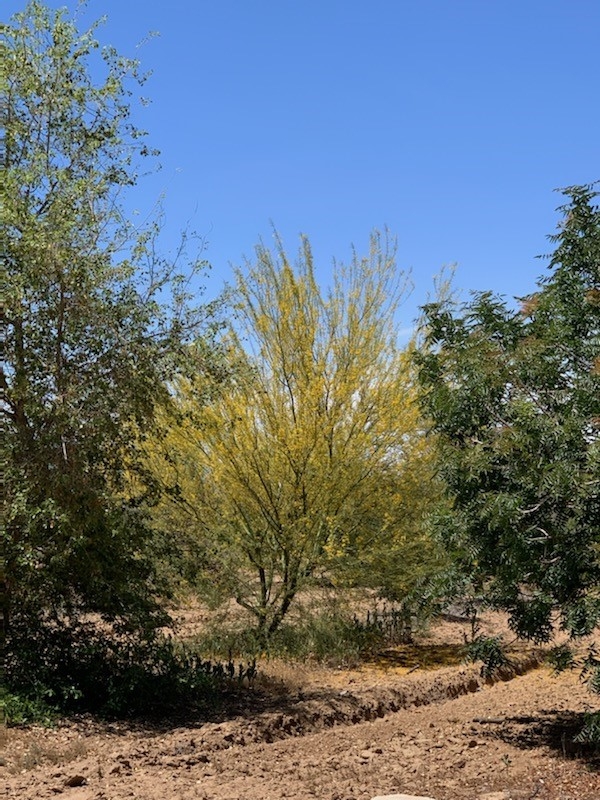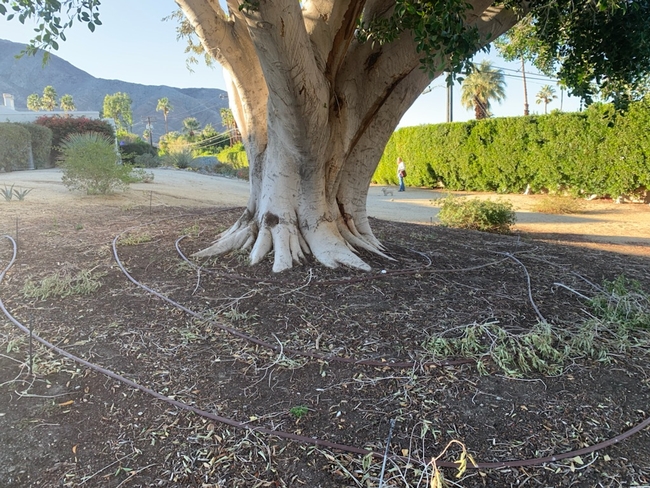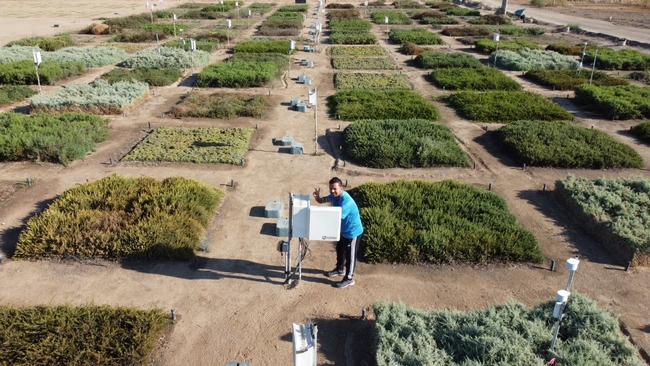Posts Tagged: ornamental
Save trees first: Tips to keep them alive during drought
Trees essential to lowering temperatures, cooling ‘heat islands'
Water restrictions prompted by the drought are driving Californians to prioritize how they will use their limited water. Because landscape irrigation is a major water use for many households, residents are looking outdoors to conserve water.
When choosing which landscape plants to save, “trees come first,” said Janet Hartin, UC Cooperative Extension area environmental horticulture advisor for San Bernardino, Los Angeles and Riverside counties. “Healthy communities need trees. Fortunately new California water restrictions allow for provisions to ensure trees receive adequate water to stay alive and healthy.”
“Mature trees are instrumental in cooling urban heat islands and we can't afford to lose them and start all over,” Hartin said. “Shade from mature trees can reduce surface temperatures by as much as 65 degrees in asphalt-covered parking lots. Shade from a single tree can reduce these surface temperatures from 165 to less than 100 degrees when air temperatures reach 110 degrees. Even with air temperatures in the 90s, surface temperatures can reach 140 degrees.”
In addition to providing shade, trees absorb and store carbon dioxide, release oxygen, enhance pollinators and wildlife habitat, filter pollutants from air and water and can reduce energy use, according to Hartin. Because trees take years to grow, they aren't as easily replaced as other plants.
As residents let lawns go brown, she recommends watering trees that are near or surrounded by lawn.
“If a tree is in the middle of a lawn, it is almost certainly watered by lawn irrigation,” Hartin said. “If it's not on a separate drip system, drag out a hose and allow the water to slowly trickle into the soil early in the morning or in the evening. Deep watering for two hours once every couple of weeks will keep most established trees alive."
In most jurisdictions, watering restrictions do not apply to hand watering and hand-held watering devices such as hoses, which may be used for longer periods of time than the restrictions permit otherwise. However, watering may be restricted in all cases to prescribed times of day.
“Check to see if your jurisdiction also requires a hose shutoff valve,” Hartin said.
“For fruit trees, we may have to forgo fruit production for a year or so. There may not be enough water to support fruit production, but the goal is to keep the trees alive during the drought,” she said.
She recommends watering trees away from the trunk, halfway between the trunk and the dripline – where the foliage ends and rain drips off the leaves – because “roots grow outward quite a distance as well as downward. Leave the hose on so the water is just trickling out,” she said. “You want water to seep into the soil and encourage the roots to grow deeper. The slow water flow will seep down a foot or so and the roots will follow, which will help anchor the tree. Move the hose around every half hour to hour in quadrants around the tree for more even watering.”
Don't have time to move the hose? Hartin suggests getting a soaker hose and wrapping it in concentric circles 2 to 3 feet apart.
“Soaker hoses are made from recycled tire rubber and allow water to slowly ooze out of the pores along the hose, distributing the water fairly evenly throughout the hose length. Avoid using soaker hoses longer than 75 feet due to pressure issues.”
To reduce evaporation around the tree, spreading mulch a few inches from trunk can help.
“Dark mulches can heat the environment so it's best not to use them,”Hartin said. “If you are in a fire-prone area, don't use organic wood-based mulches because they are flammable. Use decomposed gravel or pebbles, rock-based products instead. To keep sunlight out and discourage weeds, large wood chip mulches should be maintained 3-4-inches deep and smaller inorganic mulches at 1-2 inches.”
Residents may want to maintain some grass for children and pets because bare feet and paws can sustain serious burns on surfaces hotter than 120 degrees.
“People don't realize how hot fake grass can get,” Hartin said. “Research I conducted last summer in the Coachella Valley and Redlands found that surface temperatures of synthetic lawns can be more than 65 degrees higher than living turf and groundcover surfaces on several dates in between May and August.”
For California lawns, there are drought-tolerant grasses that can thrive on 30% less water than bluegrass and other cool season varieties. Examples are buffalograss and bermudagrass. They still require maintenance, such as mowing, but are great for play and recreational surfaces for people and pets.
Jim Baird, UC Cooperative Extension turf specialist based at UC Riverside, said, “Turfgrasses offer numerous recreational, aesthetic, and environmental benefits including player safety, property value, mental health, erosion control, groundwater recharge and surface water quality, organic chemical decomposition, carbon sequestration and environmental cooling.”
There are also non-turf groundcovers that are drought resistant.
“As they transpire, plants cool the environment. We have more and more drought-resistant alternatives to high-water-requiring plants on the market now, and that's where we should be going,” Hartin said.
For people considering replacing their lawns and adding new landscape plants, she recommends planting low-water using groundcovers in the fall.
“It's too hot to plant in summer and even native and drought-resistant plants require water several times week until they get established,” she said.
Most counties have a UC Master Gardener Program with a helpline staffed by well-trained volunteers dispensing advice to help keep plants alive and recommend plants that are well-suited for the local environment. Find a local UC Master Gardener Program at https://mg.ucanr.edu/FindUs.
University of California Cooperative Extension
Drought and Landscape Tree Care Resources
Keeping Plants Alive Under Drought and Water Restrictions (English)
https://anrcatalog.ucanr.edu/pdf/8553.pdf
Mantener las plantas del exterior vivas con poca agua (Spanish)
https://anrcatalog.ucanr.edu/pdf/8628.pdf
Prioritizing Trees Under Drought and Water Restrictions (5-minute video)
https://www.youtube.com/watch?v=CTKLlJgdLVk
Tips to Keep Your Landscape Trees Alive During Drought
Landscape Tree Irrigation to Maximize Tree Health, Benefits, and Beauty
Landscape Tree Irrigation 101
Top 10 Ways to Conserve Water in Your Landscape and Garden
Use of Graywater in Urban Landscapes in California
https://anrcatalog.ucanr.edu/Details.aspx?itemNo=8536
Persimmons, A Colorful Fruit of the Late Autumn
Persimmons are one of the last fruits of the season and among the most colorful with dramatic autumn leaves and bright orange fruit. October is the month that persimmons ripen in our area and the fruit can be used in many ways from fresh or dried fruit to an ingredient of cookies, puddings or salads. The bright orange fruit also makes a colorful addition to autumn displays.
The species originated in central China and the persimmon cultivars commonly grown in California, Diospyros kaki spp., were originally cultivated in Japan. Between 1870 and 1920, the USDA introduced several Chinese and Japanese cultivars to the southern and western U.S. but now most persimmons are of the D. kaki species and are grown in the San Joaquin Valley. The native North American persimmon species, Diospyros virginica, is not found in California and the fruit is inferior to the cultivated species.
Persimmons are deciduous trees and the leaves turn dramatic colors in the autumn. The bright orange fruit will remain on the tree after the leaves fall creating a beautiful specimen for photography. The bark of a persimmon tree is deeply fissured with distinct rectangles. The species is in the ebony (Ebenaceae) family and persimmon wood and bark are dark. Persimmon trees are both colorful and drought resistant. but adequate water is required for an adequate fruit crop. Persimmons grow as a single or multi-stemmed tree and reach approximately 25 feet at maturity. Inconspicuous flowers are borne in the leaf axils of new growth from one-year old wood. Most cultivars are parthenocarpic. The set fruit remains inconspicuous and green until ripening to a bright orange fruit.
Persimmon trees are either male or female and sexual expression can vary from year to year. Most cultivars are parthenocarpic and set seedless fruit without pollination. Persimmons are classified into two general categories, those bearing fruit that is astringent until soft ripe and those whose fruit is not astringent; within each category are cultivars whose fruits are influenced by pollination (pollination variant) and those that are not (pollination constant). Fertilization of pollination variant cultivars results in the formation of seeds and fruit with a different flavor and texture than from non-pollinated fruit. Persimmon trees often set abundant fruit and although some self-thinning occurs in late spring, the largest fruit result from judicious hand thinning to one or two fruit per twig in May or June. Persimmons are easily planted as bare root trees in early winter and the two main cultivars grown in California are readily available from local and mail order nurseries.
Persimmons are relatively disease and pest free. The primary insect pests of persimmons are mealybug and scale in association with ants. Vertebrate pests including gophers and ground squirrels can scour roots and girdle trunk stems. The ripe fruits are a favorite of many vertebrates including squirrels, rats, opossums, deer and, of course, birds.
The two most widely grown cultivars in California are the astringent variety ‘Hachiya’ with oblong, conical fruit and the non-astringent variety ‘Fuyu’ with flat, faintly four-sided fruit. Astringent varieties can be harvested when fully colored but still hard and ripened at room temperature off the tree, or stored hard in the refrigerator for up to a month before being allowed to ripen. Although tree ripening will improve astringent fruit, birds will likely destroy the crop as it ripens fully. Non-astringent varieties can be harvested when fully colored and allowed to soften slightly off the tree. Non-astringent persimmons will soften significantly even when refrigerated when stored with other fruit.
Although astringent fruit must be jelly-soft before being edible, the soft fruit can be used in cookies, breads and puddings. The fruit contains considerable pectin and will add significant body to a smoothie! Non-astringent fruit can be eaten like an apple or added to autumn salads. All persimmons make excellent dried fruit and drying will remove the astringency from hard astringent fruit. Astringent fruit can be dried by hanging from the stem, either peeled or unpeeled and results is a sweet date-like confection.
Persimmons should be harvested by cutting the stem with hand shears, leaving he calyx intact. The stem should be cut close to the calyx unless a short piece of stem is required for drying. Harvested fruit should be handled with care, even if hard, to prevent bruising.
References:
UC Davis Fruit and Nut Research and Information Website for Persimmons (2013)
http://fruitandnuteducation.ucdavis.edu/education/fruitnutproduction/Persimmon/
Pomegranate Fruit Facts (1996) - California Rare Fruit Growers
http://www.crfg.org/pubs/ff/persimmon.html
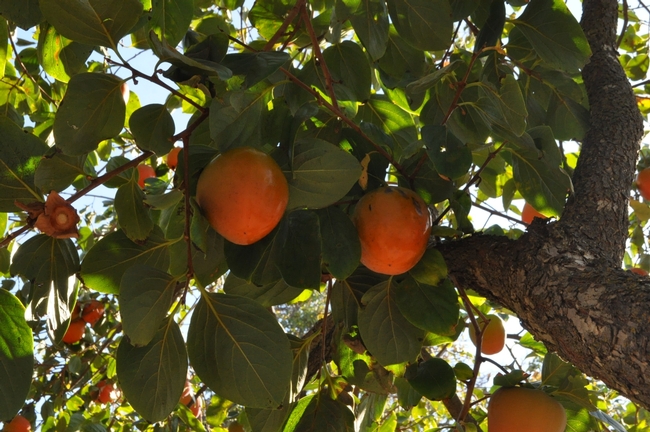
Beautiful orange persimmon ornaments. (photo by Rich Zimmerman)
Intimate Gardens
On May 19th I had the distinct pleasure of seeing the eight gardens listed in the 2013 Vallejo Garden Tour. My focus was on intimate gardens, places where one could do some quiet reflection or meditation or to talk quietly with an intimate other.
Of course, there is an ornamental and utilitarian (such as veggies and cut flowers) side to gardens, and there was plenty to be seen along those lines. But looking at gardens from the “quiet reflection” point of view gave me purpose and a framework from which to look, not to mention inspiration for creating my own. And I found plenty of what I was looking for.
Many of the gardens had special places, some sun-drenched, and some inviting filtered light, and often with the sound backdrop of a wonderful fountain, with a seemingly unlimited array of styles and sounds. In fact,
I found many interesting water features, including a waterfall in one corner of a small backyard garden, cascading down a 6-foot slope. At that same location, creeping fig (Ficus pumila) nicely covered what might otherwise be an unsightly wall of concrete block.
What inspired me was the combined plantings of perennials and annuals often as an understory of larger shrubs and trees. There were countless Japanese Maples (Acer palmatum), one of my favorites for color and form. And clumps of geraniums (Pelargonium), meticulously placed for their shady or sunny locations, often with lush splashes of ferns.
And interspersed among the foliage and color were interesting statuary and other “garden art objects”, too many to detail here, but very fitting with the intimacy of each location.
A favorite ground cover was Blue Star Creeper (Isotoma fluviatilis), which can take sun and fill in nicely between pavers, adding to the feel of a softly carpeted area.
All in all, it was a gorgeous day, and I came away inspired to use much of what I saw as ideas to create my own quiet garden space.
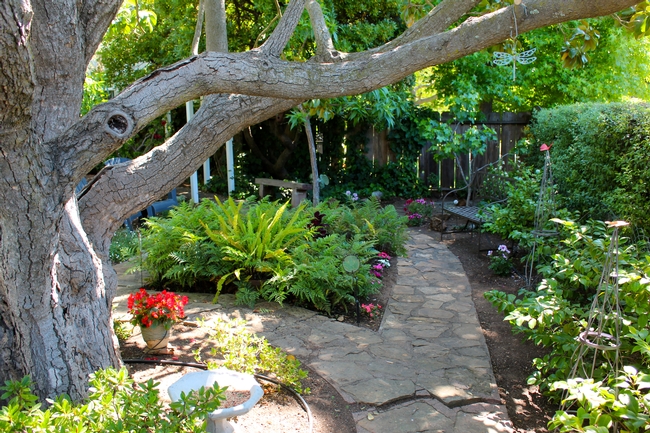
photos by Bud Veliquette
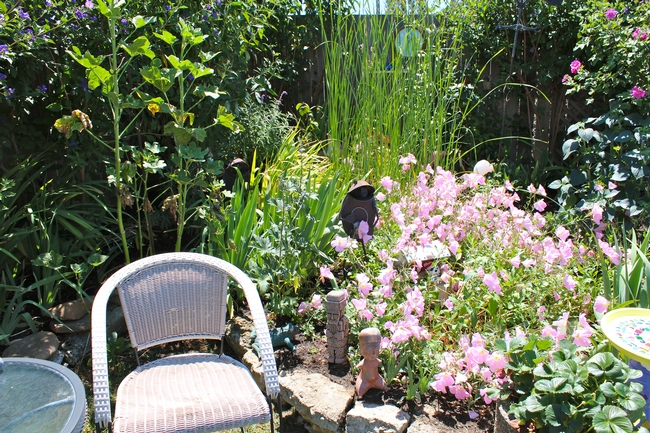
IMG 1060
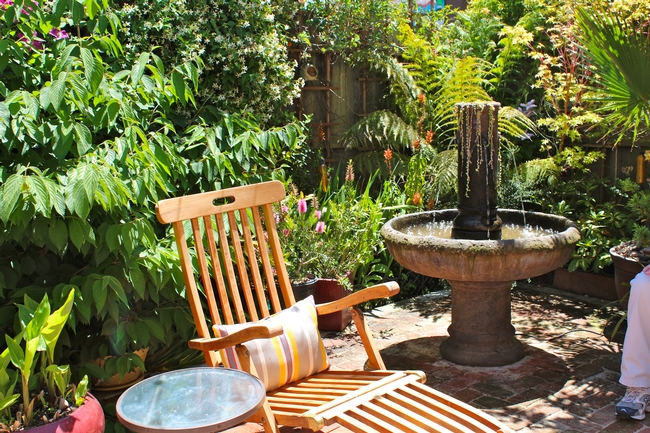
IMG 1062
Pop Goes the Garden
It’s like a rainbow of colors out there! As I look out my kitchen window, it seems overnight there was a color riot in the backyard! I have a lot of plants that flower from spring until fall, so I really enjoy the garden for those months of the year. In bloom right now are sweet peas, borage, ceanothus (Ceanothus ‘Dark Star’), a variety of sages, marguerites, daffodils, Lady Banks Rose, weeping butterfly bush-that’s just to name a few!
The benefit to having such hues in the garden is the wildlife it attracts. I see bees, birds, spiders, and cats playing in the jewel tones.
Just the other day, I was having a look at the backyard with a critical eye. I decided that I need to add more colorful foliage and movement to the yard. I plan on adding ornamental grasses and bronzed, variegated or other-than-green plants to my yard. Granted, the flowers are colorful, but the majority of the yard is just green foliage when the flowers are gone.
In the next few weeks I am going to Annie’s Annuals in Richmond and also a UC Davis Arboretum Invitational for Master Gardeners. I hope to find the plants I am looking for that will spice up the yard for the 'plain green' times of the year.
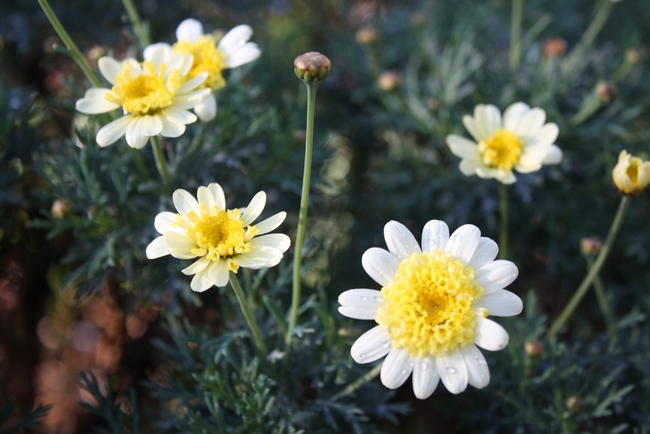
Argyanthemum 'Lemon Sugar' (photos by Jennifer Baumbach)

A honey bee on Ceanothus 'Dark Star'.
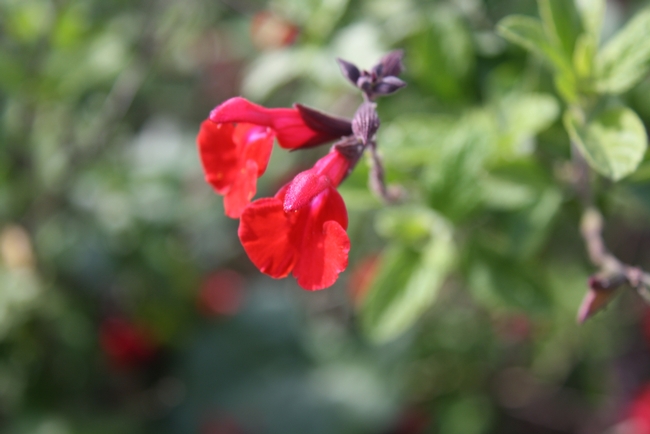
Salvia 'Cabrillo Sunset'
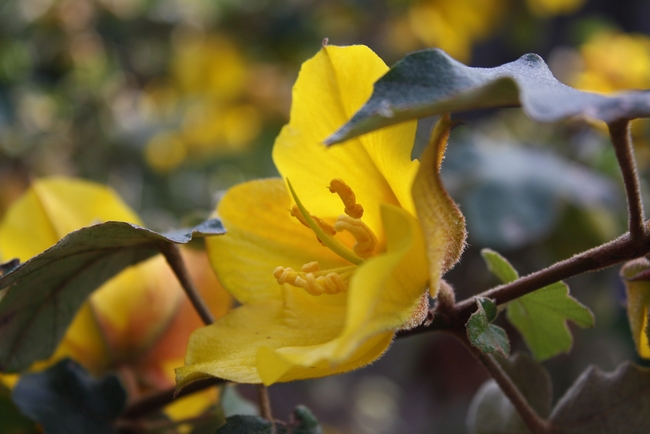
Flannel Bush (Fremontodendron spp.)
The BIG Chop
On Groundhog Day — Feb. 2 — Punxsutawney Phil saw his shadow, ushering in six more weeks of winter. Solanoans hadn’t seen winter YET, save for two days of rain in January. And, as if to prove Phil totally wrong, Feb. 2 in Vacaville was particularly stunning: About 70 degrees in the sun, thin clouds blowing by in a light north wind.
It was the perfect day to start the Big Chop.
John Greenlee, the grasses guru, suggests an annual buzz cut — he calls it “the Big Chop” — for most ornamental grasses. The grasses in my yard are winter dormant, and by the time Feb. 2 rolled around, were looking downright tatty. In fact, a good many of the plants in my yard look pretty used up by late winter. So I take Greenlee’s advice, and do a major trim on not only the grasses but also the Western natives (such as Copper Canyon daisy, Tagetes lemmonii), herbaceous choices (such as threadleaf coreopsis, Coreopsis verticillata) and Mediterranean plants (like Jerusalem sage, Phlomis fruticosa) scattered throughout the yard.
Greenlee the grasses guy explains that, in their natural settings, grazing animals or wildfire would mow down most of these plants. Winter cold — when it happens — often takes herbs down to the soil line. Since few of those things occur in my yard, I get to stand in for grazers, fire and cold. Makes me feel like Mother Nature’s girl Friday.
The Big Chop takes days. I lucked out this year; Feb. 2, 3 and 4 were beautiful. I filled our green-waste toter within the first three hours, then borrowed several of my neighbor’s unused smaller garbage cans and promptly filled those. Some of the trimmings went into our overstuffed compost piles. There’s never enough space for all the editing my yard requires.
The result: A yard that looks completely different. From bushy to buzzed, tatty to tidy. This annual trim fest also gives me the opportunity to really clean up around these plantings, something I like to do just once a year.
And, in all honesty, my back won’t allow more than one Big Chop a year.
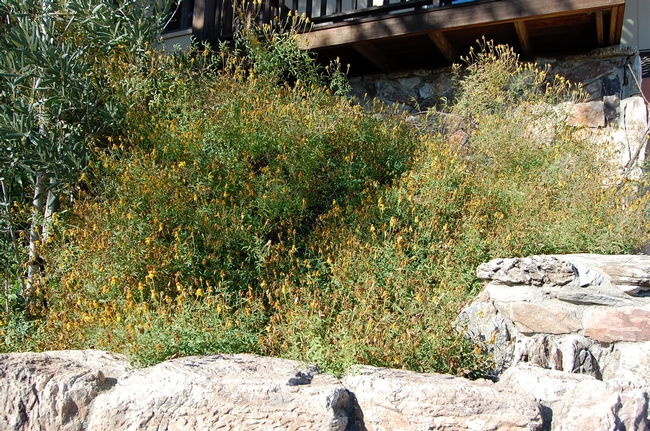
Copper Canyon daisies (Tagetes lemmonii) are done blooming, and in need of some serious editing. (photos by Kathy Thomas-Rico)
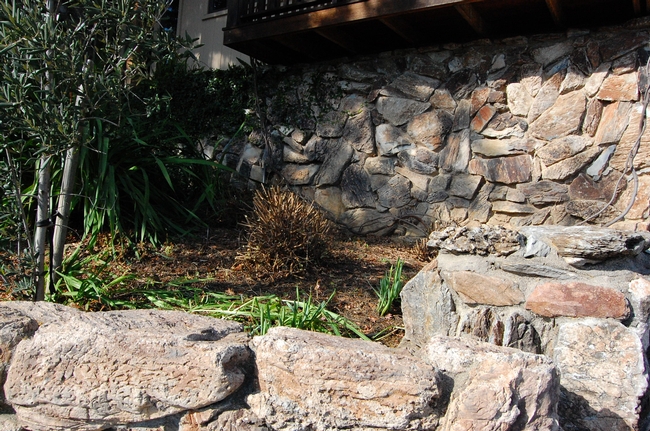
Done!


